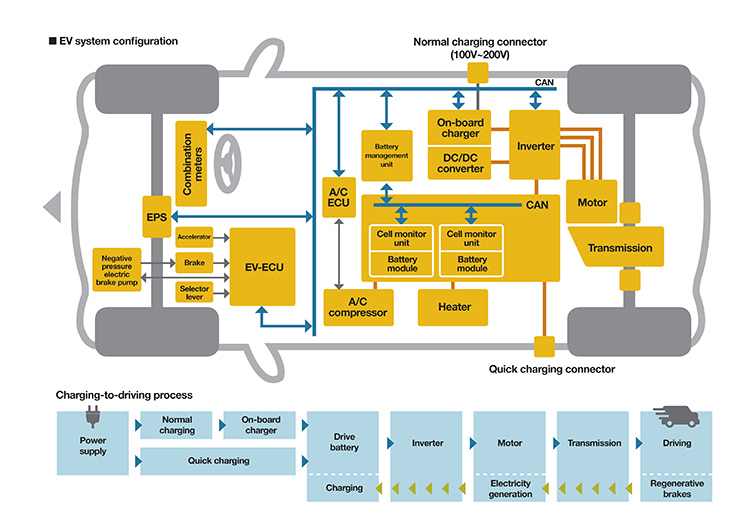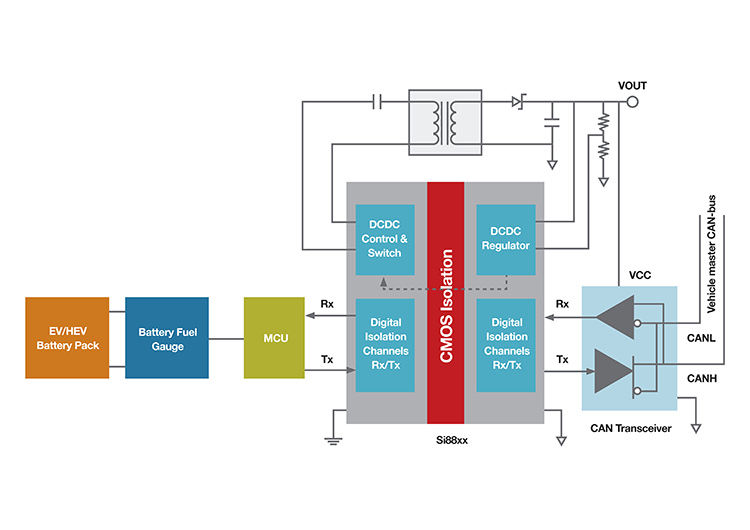Future-proofing EV battery management systems
Despite the current boom in electric vehicle (EV) and plug-in hybrid electric vehicle (HEV) production, actual interest among consumers may be in danger of lagging behind. Rudye McGlothlin, Marketing Director, Power Products, Silicon Labs explains.
According to the results of a recent survey by an automotive research company, concerns about EV battery range remain the biggest barrier to adoption among consumers who are not yet considering moving away from vehicles with a traditional internal combustion engine (ICE).
Drivers of EVs often suffer from an increasingly common but peculiar ailment of ‘range anxiety’. ICE vehicle drivers don’t experience this anxiety because their refuelling stations can be found just about anywhere that the road will take them, and the process of filling up their tanks typically takes no more than a few minutes.
Many people who purchase EVs do so with the intention of using them purely for work-home commutes. Travelling from one’s home to the office and back five or six days a week takes most of the unknowns out of running an EV; either the vehicle will be charged overnight at home or perhaps at a faster charging station close to the workplace, or in some cases at the workplace parking garage.
However, range anxiety returns at the mere thought of taking a weekend road trip across the countryside. To counter this, ongoing innovations in semiconductor technology are paving the way to make charging much faster and improving range for electric vehicles.
An overview of EV systems
EVs follow a modular approach (Figure 1) when it comes to the drivetrain and energy storage and conversion systems. Typically, these components are grouped into the following major circuit assemblies:
- On-board charger (OBC): the vehicle’s lithium-ion batteries will be charged by an OBC, which includes an AC-DC converter with power factor correction (PFC).
- Battery management system (BMS): the status of the vehicle’s individual battery cells is monitored by the BMS to ensure maximum efficiency and safety against overheating, over- or under-charging.
- DC/DC converter: the high-voltage battery is connected to the internal 12VDC network via the DC/DC converter. The internal DC network provides power to the accessories and bias to the local switching converters.
- Main inverter: converts high-voltage DC/AC to drive the electric motor. The main inverter is also used for regenerative braking and returning unused energy to the battery.
BMS and CAN BUS
As for EV batteries, they may be getting more powerful, but the demands placed on them are also steadily increasing as more complex electronics are being added for more efficient maintenance, charging and usage in the drivetrain. In turn, these systems require precise measurements of vital safety elements such as battery pack voltages, currents and temperatures. However, these measurements are communicated via high-voltage rails that pose a potential danger to the sensitive electronics collecting and processing the data.
For example, the BMS transmits essential real-time data about the battery’s status to the driver via the vehicle’s central on-board computer. Safeguarding the accuracy and smooth operation of this communication is a vital step towards eliminating range anxiety for drivers. The danger lies both with high voltage and noisy switching - the former from the battery, which in the next few years could have a capacity of 800V or higher, while the latter is posed by the battery management system communicating with the central processing unit.
This simplified BMS system in Figure 2 shows the importance of signal and power isolation for interfacing with one of the EV subsystems. Modern digital isolation requires a power supply on both sides of the isolator, and this can also be used to power other devices attached to the isolator such as a CAN bus transceiver. The high-voltage domain is the side with the battery pack, and the low-voltage domain is the side with the CAN transceiver.
Although the example in Figure 2 focuses on the CAN bus interface, additional isolation may be needed between the battery pack and the microcontroller (MCU). The best option for isolating various subsystems with CAN transceivers is to use an isolation solution with integrated DC-DC power conversion to avoid overcomplicating the overall system design.
The promise of wide bandgap semiconductors
The inevitable introduction of new systems will increase the number of semiconductors and other electronic components, thereby increasing the demand for power from the battery. Typically, this additional demand will add cost and weight to systems, and in the EV market, more weight means less overall efficiency. And as bus voltages go up, so does the cost of a silicon transistor.
It’s clear that traditional silicon technologies such as Si MOSFETs, IGBTs and superjunctions just won’t cut it any more for EVs. The industry is already starting to design in the most cutting-edge wide bandgap (WBG) technologies available, such as silicon carbide (SiC) and gallium nitride (GaN), both of which have their specific advantages within the electric vehicle.

Above: Figure 1. An example of a typical EV automotive system architecture
SiC technology offers the benefits of higher temperature operation, higher blocking voltage and significantly faster switching speeds than Si IGBTs. At the heart of the EV drivetrain, traction inverters intermittently transferring large packets of energy back to the battery will see the biggest benefit from SiC switches. On the other hand, GaN switches provide advantages to a range of other power systems ranging from low-power systems right up to 10kW (including AC-to-DC OBCs and DC-to-DC auxiliary power modules).
However, because GaN and SiC make use of higher switching speeds, they can produce significant amounts of noise. Thus, as automotive suppliers start to adopt WBG power transistors to meet ever-increasing demands for power density, semiconductor-based isolation becomes not just a nice-to-have, but a critical item on the BOM.
Unlocking better performance
To be truly competitive with ICE vehicles, EV battery management and power conversion systems must be small, lightweight and light on battery power use while delivering high-efficiency power to the electric motor.
Achieving more widespread adoption lies not just in addressing misconceptions about range and cost, but also in ensuring that electric vehicle manufacturers future-proof their battery management systems at the design level as much as possible.

Above: Figure 2. Battery management system communication interface
Despite the challenges, as the cost of vehicle electrification goes down and related system design experience grows, breakthrough technologies will usher in a new phase of innovation as the individual systems become cooler, faster, smaller and more efficient. That is when we will see what EVs are truly capable of.











